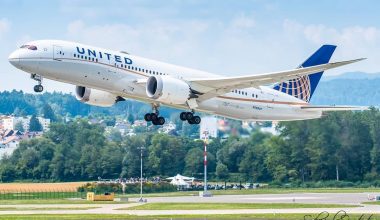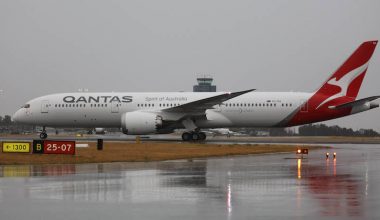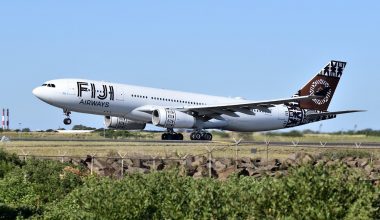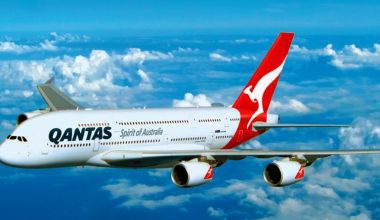If you are looking for a peaceful getaway in South Pacific, make Fiji Airways a part of your plan. With 26 direct-flight destinations, the flag carrier of Fiji is a prominent carrier in the Pacific Ocean region. Fiji Air has served the South Pacific island community for over 60 years and connected the world to Fiji. It operates a robust flight schedule allowing visitors to explore Fiji’s rich and relaxing islands easily and conveniently.
Booking flights with Fiji Air gives you wings to soar around the majestic blue skies of the South Pacific. No other carrier serves more Pacific Island countries than this Nadi-based carrier.

Fiji Airways General information
- Fiji Airways is the flagship airline of the island country Fiji, founded in 1947. The government of Fiji has a 52% stake in the airline, whereas the Australian flag carrier Qantas holds 46%. The remainder, i.e., a 2% stake, is shared among state authorities of several Pacific island countries.
- Fiji Airways began its career by launching its first commercial flight on 1 September 1951. Starting from obscurity, Fiji’s national carrier has carved a rich history with the most extensive South Pacific network of any airline.
- Headquartered in Nadi, Fiji Airways consolidates its flight operations from its primary hub at Nadi International Airport. It also runs a secondary hub at Nausori International Airport to operate additional flights to Auckland, Port Vila, and Sydney.
- Fiji Airways is the first and only Oneworld Connect partner globally, joining the Oneworld membership platform in December 2018.
- Fiji Air maintains a fleet size of 12 jets and a route network spanning 26 cities across 14 countries.
Fiji Air route map: How many destinations does Fiji Airways fly?
The majority government-owned Fiji Air serves 26 international destinations in 14 countries and territories. It holds a fair share of the Pacific Ocean market, with its route map covering the neighboring countries of Kiribati, Solomon Islands, Tonga, Tuvalu, Vanuatu, and Samoa.

Fiji Air flies a fully international route network and offers scheduled domestic services via the Fiji Link subsidiary. The international destinations served by Fiji Air include:
Oceania
- Australia-Adelaide, Brisbane, Melbourne, and Sydney
- New Zealand-Auckland, Christchurch, and Wellington
- Samoa-Apia
- Solomon Islands-Honiara
- Tonga-Neiafu and Nuku’alofa
- Tuvalu-Funafuti
- Vanuatu-Port Vila
- Kiribati-Kiritimati and Tarawa
Asia
- Japan-Tokyo
- Hong Kong
- China-Beijing, Hangzhou, and Shanghai (all are seasonal charter destinations)
North America
- The United States of America-Honolulu, Los Angeles, and San Francisco
- Canada-Vancouver
Fiji Air flights to Australia
Australia is Fiji Air’s most-served country in terms of no. of destinations. Given the largest Fijian population in Australia outside the country itself, it’s logical for Fiji Airways to spread its wings to Australia as much as possible. The national carrier operates Australian flights to cater mostly to Australian and Kiwi families.

The Oneworld Connect Partner currently enjoys a presence in four Australian airports. Adelaide Airport, Brisbane Airport, Melbourne Airport, and Sydney Airport. Moreover, Fiji Airways will further fortify its Australian foothold by adding Canberra services in 3rd quarter of 2023. It will operate two weekly frequencies on the Nadi-Canberra route, effective 21 July-29 September 2023. Its Canberra flights are scheduled as follows:
- FJ951: Depart Nadi at 09:15 and arrive in Canberra at 12:20 local time
- FJ950: Depart Canberra at 13:35 and arrive in Nadi at 19:40 local time
Fiji Air flights to the US
At present, Nadi-based Fiji Airways operates five intercontinental flights to the US (three to Honolulu and one each to Los Angeles and San Francisco).
Daniel K. Inouye International Airport (HNL) receives maximum Fiji Air services among all US airports. The national carrier of Fiji serves HNL from Apia-Faleolo, Kiritimati, and Nadi.
Furthermore, the Fijian flag carrier connects Los Angeles International exclusively from its operating base in Nadi. The same goes for San Francisco International Airport, which also receives Fiji Airways’ flights from Nadi.

The Nadi-headquartered airline uses a mix of A330 and A350 jets for direct intercontinental trips to the US. It mostly deploys A350-900 to over 5539-mile distance from Nadi International to Los Angeles in 10 hours 15 minutes. Similarly, it uses A330-200 to serve ten h 30-minute flights from Nadi to San Francisco.
However, the carrier’s one-stop flight to Honolulu is on a Boeing 737 Max 8. Before arriving at the final destination, those flying from Nadi to Honolulu have a layover at Faleolo International (Apia) or Cassidy International (Kiritimati). Both flights, i.e., Nadi-Apia /Nadi-Kiritimati and Apia-Honolulu/Kiritimati-Honolulu, are performed using Boeing 737 Max 8 aircraft.
Fiji Airways has two Airbus A350-900XWB new-generation aircraft in its order book. Procuring these advanced widebodies will pave the path for Fiji Air to penetrate further into the US market. The carrier plans to go deeper into the US by adding Dallas Fort Worth, Chicago O’Hare, and Houston Intercontinental services.
Fiji Air fleet: What aircraft does Fiji Airways fly?
Fiji Air touts a modern and environmentally compatible fleet of 12 Airbus and Boeing jets. The well-structured mainline fleet of Fiji Air consists of 3 Airbus A330-200s, 1 Airbus A330-300, 2 A350-900s, 1 Boeing 737-800, and 5 Boeing 737 Max 8s.
Currently, Fiji Airways operates European and American jets equally (6 Airbus and 6 Boeing jets). But the main difference is all Airbus jets in Fiji Air’s fleet are widebodies, whereas those belonging to Boeing models are narrowbodies.
- Fiji Airways Airbus A330
The Fijian national airline operates two Airbus A330 variants, i.e., A330-300s and A330-200s. Having entered revenue service in January 2016, the A330-300 aircraft operates the carrier’s medium and long-haul routes. The 313-seat A330-300 is formatted with two cabins- Business (24 seats) and Economy 9289 seats).

Likewise, the carrier’s Airbus A330-200 can accommodate 273 passengers between two cabins, i.e., 24 in lie-flat business seats and 249 in standard economy seats. The A330-200 jet presents a landmark acquisition for Fiji Air that heralded the carrier into a widebody era. It joined the airline’s fleet as the first-ever widebody in 2013.
- Fiji Airways Airbus A350-900
The fuel-efficient, state-of-art Airbus A350-900 forms the backbone of the airline’s long-haul operations. The twin-aisle aircraft comfortably seats 334 passengers and offers the ultimate long-haul flying experience with privacy and comfort.
The A350-900’s business cabin is laid out in a 1-2-1 configuration with 33 Collins Aerospace Super Diamond, fully lie-flat beds. High-paying customers will get the ultimate luxury air travel to Fiji with 44’pitch lie-flat seats and the latest AVANT IFE on a 17” monitor.

Likewise, the economy cabin is set up in a 3-3-3 protocol with 301 long-haul Recaro Economy seats. Among these, 39 are BULA SPACE seats featuring 34 inches of legroom, a 6-degree recline, in-seat 12” monitor, and sockets and USB ports.
- Fiji Airways Boeing 737 Max 8
Fiji Airways is the foremost carrier in the South Pacific region to induct next-generation Boeing 737 MAX 8s on short and medium-haul routes. Boeing 737 Max 8 is the most dominant model in Fiji Air’s fleet, accounting for 5 of 12 total jets.

Powered by CFM LEAP-1B engines, B737 Max 8 flies as far as 3515nm and minimizes fuel burn by as much as 14%. It elevates the onboard travel experience with less noise, modern sculpted sidewalls, LED lighting, and more overhead cabin space.
Like every other Fiji Air fleet aircraft, Boeing 737 Max is outfitted with a 2-class setup. The 170-seat aircraft can accommodate eight passengers in business class (51” pitch, 8” recline) and 162 in economy class (32” pitch, 5” recline).
- Fiji Airways Boeing 737-800
The Boeing 737-800 is outfitted with 170 seats in a dual-class layout (8 in business and 162 in economy).
Fiji Airways’ codeshare partners
Fiji Airways has entered a codeshare partnership with multiple airlines to enable South Pacific islanders to reach virtually anywhere worldwide. Such agreements enhance the carrier’s presence in international markets and allow it to offer more benefits to its customers. Fiji Airways has 16 codeshare partners, which extended Fiji Air’s network to 108 international destinations.

Fiji Airways’ codeshare partners in the US include American Airlines and Alaska Airlines. Similarly, its Oceanic partners include Air New Zealand, Jetstar, Qantas, Samoa Airways, Air Vanuatu, and Solomon Airlines. The carrier’s codeshare relationship extends beyond Oceania to include Asian airlines like Air India, Hong Kong Airlines, Cathay Pacific, and Japan Airlines. Likewise, it provides its customers with accessibility to/from European cities via codeshare agreements with British Airways and Finnair.
Role of Fiji Air in tourism development
The island country of Fiji relies on air transport to bring in international visitors. The national carrier Fiji Air alone accounts for more than 50% of visitors who fly to this South Pacific gem. Through its codeshare partners, the Fijian airline welcomes visitors from all around the globe to the ultimate island holiday destination. Fiji Air is a driver of tourism to Fiji and offers visitors an authentic peek into Fiji’s air-centric lifestyle. It provides much-needed connectivity to build on the inbound tourism that is the lifeblood of the home nation’s economy.






